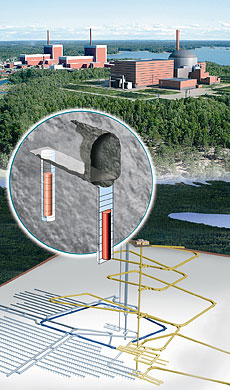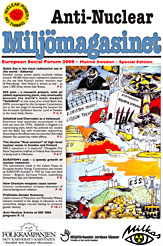Olkiluoto waste
Swedish geology professor Nils-Axel Mörner after an expedition in Olkiluoto, Finland, the construction area of the nuclear waste repository.
The discoveries of huge seismo-tectonics and liquifaction in the area prove that Olkiluoto has historically been heavely affected by earthquakes. Do You believe it won´t happen again during the nearest 100.000 to 4,5 billion years that the repository is supposed to protect the environment from the most dangerous – nuclear – waste ?!
Read even a book on the subject (swedish) Seismotektoniska Grottor i Finland. NA Morner
httpv://www.youtube.com/watch?v=ULJH7X0fgSE
http://www.youtube.com/watch?v=ULJH7X0fgSE
Geology week with Pr Nils-Axel Mörner
9+16-22 maj 2011
You may attend an uforgettable and spiritual geology 1 week univeristy event in the landscapes around Skottvångs Mine in Sweden. See the program in Swedish: TNKK-2011
Nuclear waste repository in Olkiluoto, Finland
A fragment from Ulla Klötzer´s article in the Anti-Nuclear magazine here on Your right side
“Finnish repository time table.
The time table in Finland is much faster: in 2009 the depth will be around 400 metres and in 2011 some 500 metres. In 2020 the loading of waste will start. Costs: 60 million euros”
Enlargement of the Olkiluoto repository by one third of it´s originaly announced size
On 9th of June 2009 a decision was announced by Posiva to enlarge the Olkiluoto repository by one third of it´s originaly announced size. All together 12.000 tons of high-level nuclear waste are planned to be buried in Olkiluoto now.
The Environmental Impact Assessment 2008
http://www.posiva.fi/files/519/Posiva_YVA_selostusraportti_en_lukittu.pdf
The Olkalo final repository in Finland
By Pr Nils Axel Mörner. 4-02-2011
Olkalo is the name of the proposed final repository of high-level nuclear waste at Olkiluoto in Finland. The method applied is the Swedish KBS-3 method implying a deposition in the bedrock at a depth of about 500 m, with a backfilling of bentonite, a sealing of the access tunnels and shafts and a guarantee that this repository will stay intact for 1 million years (according to Posiva).
Instead of presenting an opus operandi of how this repository was going to be constructed and kept intact for the immense time period of 1 million years, the Finnish Government took “a decision in principle” (in years 2000 and 2001) that a final repository was allowed to be built at Olkiluoto (close to Rauma in SW Finland). During the construction, the Government assumed that problems were to be revealed and cooped with.
This is, of course, a terrible way of handling such a delicate safety issue as the protection with 100% safety of this high-toxic material for 1 million years into the future.
Anyone should understand that no one has the capacity to predict anything over such a time period as 1 million years. Just claiming that you can do so, should discriminate tem as being not serious and unscientific, or, more directly spoken; to spread invalid disinformation.
With that as a philosophical-ethical dismissing of Posiva’s claim and assurance, we must turn to the proposed safety of the individual barriers; one by one.
The old idea (from the 1950s) of a nearly total stability of the Fennoscandian bedrock has, in recent years and by very clear observational facts, become totally dismissed and substituted by an understanding that, even our bedrock, is highly instable. This is especially the case when the land ice melts away after an Ice Age and the land rises at exceptionally high rates. The earthquakes are high in magnitude and numerous in frequency (recently well documented in the Rauma area). In such an environment, no repository hidden in the bedrock would remain safe. And in the future, we will surely pass through new glaciation and deglaciation periods. A totally new findings is the occurrence of explosive methane venting when methane ice accumulated in bedrock voids suddenly transform into methane gas (at a volume rate of 1:168). This is especially dangerous for Olkiluoto where the bedrock is unusually rich in methane. Another factor is the proposed “safe distance” for a repository to regional faults. Posiva claims that this distance is in the order of 100 m – observational facts would suggest a distance of 5 to 10 km. This is vital for the Olkiluoto repository as the area is traversed by numerous faults and fracture zones.
The duration of the canister has been questioned. The behaviour of the bentonite filling seems far from clear. In saline water the swelling minerals behave far from assumed.
In conclusion, many shortcomings seem to be connected with a KBS-3 repository, and the long-term safety can certainly not be guaranteed.
We can see why the Finnish Government took the strange decision that a KBS-3 repository would, “in principle”, satisfy the goals set. This was to open for and allow for the building of new nuclear power plants (Olkiluoto 3). Unfortunately, it also opened, at least in principle, for uranium mining in Finland.
Pr Nils-Axel Mörner


